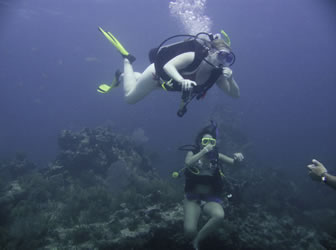Underwater Photography
 One of the most interesting and challenging aspects of the fast evolving photography world is the last great unexplored frontier just beyond the beach and into the ocean. When you step into the water and slip under the surface you have entered a strange new world where the normal experience with light, color, and form don't seem to apply.
One of the most interesting and challenging aspects of the fast evolving photography world is the last great unexplored frontier just beyond the beach and into the ocean. When you step into the water and slip under the surface you have entered a strange new world where the normal experience with light, color, and form don't seem to apply.
Whether you have a $10 disposable camera (note: cell phones do poorly in the water) or a multi- thousand dollar rig with lights and cases the basic understanding is the same. Here we will lay out some of the facts about water photography to "wet" your appetite so to speak. If this peaks your interest please know that PADI offers several classes in photography and underwater certifications that are well worth the time and training.
So why does everything look blue in your picture or why indeed does the swimming pool (at least a clean one) look blue? The answer is water does some crazy things. One of the properties of a water molecular is that it has the ability to absorb colors in white light, Remember that white light has all of the rainbow colors mixed together. When there are no colors we have black. So if you have the chance to descend to over a 100 feet into the sea it starts getting very dark. At a thousand feet it is pitch black and the only light is what you bring or the sea life generates in a bioluminous glow. So bring your lights if you want to get deep.
What about lesser depths, Well that too is going to have some color loss according to the distance from your subject. Water absorbs light starting at Red-Orange-Yellow-Green-Blue about every 10ft. So at just 10feet you will quickly have a lack of red. At 20 Feet orange and so on until below 40 feet it is mostly blue left in the light available. Note a slightly more realistic way to think is slant range rather than just depth. As you can see in the picture above we are just 25 feet down in the Florida Keys on a coral reef and it is really mostly blue from both depth and slant range from the camera. Note even without a flash most modern cameras can handle the lower light level although grainy. You can also set the white balance to compensate on many cameras just made for water use that increase the reds, etc.
Another small point is that water in the sea is not perfectly clean. Light from your flashlight or strobe tends to bounce off and highlight particulate matter in the camera view. Lesson here is shoot close and wide not far, unless it is a great white then I shoot from the boat period. Water also has one more gotcha and that is the magnification of subjects underwater - they appear larger due to the distortion that water provides.
Still the world below is fun and challenging and you must have pictures to prove your adventure. Good hunting and contact us if you have questions.